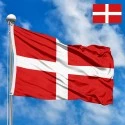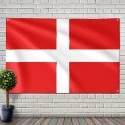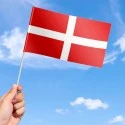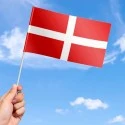The flag of the Sovereign Military Order of Hospitallers of Saint John of Jerusalem, of Rhodes and of Malta, more commonly known as the Order of Malta, is one of the oldest and most unique symbols in the world. It is not merely the flag of a state in the traditional sense, but the banner of a sovereign subject of international law, which has no territory of its own, yet possesses extensive diplomatic relations and actively participates in humanitarian activities worldwide. The Order's flag embodies its more than 900-year history of service, charity, and defense of the faith.
Description and Elements of the Flag
The flag of the Order of Malta, also known as the Flag of the Order (Bandiera dell'Ordine) or the State Flag (Bandiera di Stato), is a simple but powerful red banner with a white Latin cross at its center. The cross extends to all edges of the fabric. The official proportions of the flag are not as strictly regulated as those of many national flags, but it is commonly used in ratios of 2:3 or 1:2. The dimensions of the cross are also proportional to the overall size of the flag, with the crossbars remaining sufficiently wide and prominent.
-
Red color: Symbolizes the blood of Christ, the martyrdom of saints, and charity. It is a color of passion, sacrifice, and devotion, which are fundamental principles of the Order.
-
White color: Represents purity, innocence, mercy, and faith. It is also the color of Saint John the Baptist, the patron saint of the Order.
-
Latin Cross: A classic Christian symbol indicating the Order's Christian roots and mission. This cross, known as "Saint George's Cross" in other traditions, has always been its primary distinguishing mark in the context of the Order.
The simplicity and clarity of the flag's design emphasize its religious and chivalric purpose, as well as the universality of its mission, which extends beyond geographical boundaries.
History of the Flag's Creation
The history of the flag is inextricably linked to the history of the Order itself. The Order of Malta was founded in Jerusalem around 1048 as a community of monks who managed a hospital for pilgrims. After the First Crusade in 1099, it received papal recognition in 1113 from Pope Paschal II, becoming a full-fledged religious order under the name of the Sovereign Order of Hospitallers of Saint John of Jerusalem.
From its very beginning, the Order adopted the white cross on a red field as its symbol. This was a standard identification mark for crusaders. The first documented mention of the flag dates back to 1120, when Pope Calixtus II authorized the knights of the Order to use the white cross on a red field as their battle standard and a symbol of their religious vow. This flag, known as the "Flag of the Hospitallers" or the "Flag of Saint John," accompanied the knights in all their campaigns and battles.
For centuries, the flag remained virtually unchanged, despite the Order's changes of residence: from Jerusalem to Cyprus, then to Rhodes (1310-1522), and finally to Malta (1530-1798). Each of these locations left its mark on the full name of the Order, but its primary symbol – the white cross on a red field – retained its original form.
During its stay on Rhodes and especially in Malta, when the Order transformed into a sovereign state with a powerful fleet, this flag became widely known as a naval and state flag. It flew on the Order's ships that patrolled the Mediterranean Sea, protecting pilgrims and trade routes from pirates and enemy attacks.
With the loss of Malta in 1798 after the Napoleonic Wars, the Order lost its territory but retained its sovereignty and status as a subject of international law. The flag continued to be a symbol of its legitimacy and independence. Currently, with the Order based in Rome and maintaining diplomatic relations with over 110 states, this flag remains its official symbol, used in ceremonies, embassies, and aid missions.
"Countries" and "Regions"
The uniqueness of the Order of Malta lies in its status as a sovereign entity that, since 1798, has not had a permanent territory. Despite this, it is a subject of public international law and exercises sovereign functions, including maintaining diplomatic relations, issuing its own passports, minting coins, and issuing postage stamps.
The main "territories" of the Order in the modern world are its extraterritorial properties in Rome, Italy:
-
The Magistral Palace (Palazzo Magistrale) at Via Condotti, 68, which is the main residence of the Grand Master and the Order's government council.
-
The Magistral Villa (Villa Magistrale) on the Aventine Hill (Malta, Via Santa Maria), which also enjoys extraterritorial status and is the venue for many important ceremonies.
Furthermore, the Order has hundreds of representations (embassies and missions) and institutions (hospitals, clinics, aid centers) worldwide, which operate based on agreements with the host countries. Thus, its "region" of influence is the entire world where the Order carries out its humanitarian and diplomatic mission.
Interesting Facts
-
"State Without Territory": The Order of Malta is a unique "subject of international law without territory." Its sovereignty is recognized by a wide range of states, allowing it to have observer status at the UN and other international organizations.
-
Two Flags: In addition to the "Flag of the Order" (Bandiera dell'Ordine) mentioned above, there is another official flag – the "Flag of the Grand Master" (Bandiera del Gran Maestro). It is also red, but instead of a simple white cross, it features the heraldic shield of the Order with an eight-pointed white cross (the so-called Maltese cross) on a red field, surrounded by a collar (royal collar) and surmounted by a crown. This flag is used only by the Grand Master and on properties under his personal care.
-
Eight-Pointed (Maltese) Cross: Although the Order's main flag uses a simple Latin cross, the most recognizable symbol of the Order, especially after its stay in Malta, became the eight-pointed white cross, known as the Maltese Cross. The eight points of the cross traditionally symbolize the eight beatitudes, as well as the eight languages (national subdivisions) of the Order that existed in the Middle Ages.
-
Oldest Sovereign Order: The Order of Malta is the oldest chivalric order in the world, existing continuously since the 12th century. It survived the fall of Jerusalem, the expulsion from Rhodes, and the loss of Malta, preserving its unique identity and mission.
-
Humanitarian Mission: Nowadays, the Order of Malta primarily focuses on its original mission – providing medical, social, and humanitarian aid. It manages hospitals, dispensaries, hospices, and outpatient clinics worldwide, helping those in need without discrimination based on race, origin, or religion.
-
Diplomatic Passports: The Order issues its own diplomatic passports to high-ranking officials, which is further confirmation of its sovereignty in international law.
Adoption and Significance for "Inhabitants" (Members of the Order)
The adoption of the white cross on a red field as the flag occurred in the early period of the Order's existence, as early as the 12th century, and was linked to its dual nature – as a religious order and as a military crusader formation. For the knights and members of the Order, this flag has had deep spiritual and symbolic meaning from the very beginning.
For modern members of the Order (numbering around 13,500 knights, dames, and chaplains, as well as over 80,000 permanent volunteers and 42,000 medical personnel), the flag signifies:
-
Belonging to an Ancient Tradition: It symbolizes their connection to a centuries-old history of chivalry, service, and faith. Anyone who sees the flag understands that it represents an organization with an incredibly rich past.
-
Commitment to the Mission: The flag serves as a reminder of the Order's two main objectives: "Tuitio Fidei et Obsequium Pauperum" – defense of the faith and service to the poor. It inspires members of the Order to continue their humanitarian activities.
-
Sovereignty and Independence: For members of the Order, the flag emphasizes the Order's unique sovereign status, allowing it to act independently of national borders and political systems in its humanitarian work.
-
Unity: Despite the geographical dispersal of the Order's members worldwide, the flag serves as a powerful symbol of their unity and common purpose. It unites them under one banner of service.
-
Identification: In places where the Order operates (hospitals, missions, diplomatic representations), the flag clearly identifies its presence and its commitment to the principles of charity and neutrality.
Thus, the flag of the Order of Malta is not merely a piece of fabric, but a living symbol of continuity, service, and the international activity of one of the world's oldest and most unique organizations, which continues to fulfill its mission of charity, based on centuries-old traditions and principles.
In the demonstration images, full-size flags are shown with proportions of 2:3, and hand-held flags with proportions of 1:2.








 Waving flag
Waving flag
 Sizes:
Sizes:
 Round flag
Round flag
 Sizes:
Sizes:
 Rectangular flag 2:3
Rectangular flag 2:3
 Sizes:
Sizes: